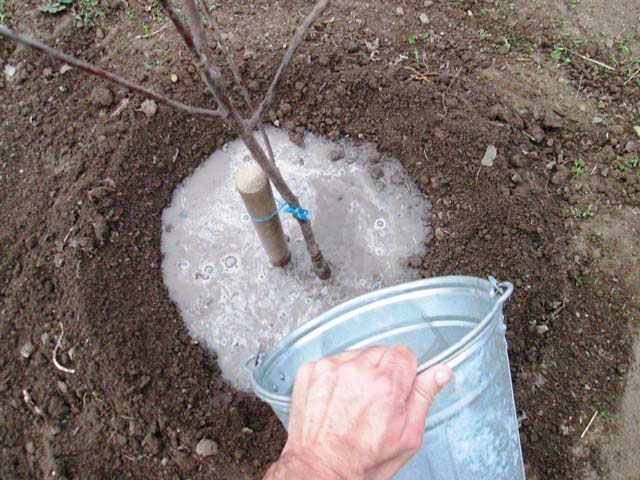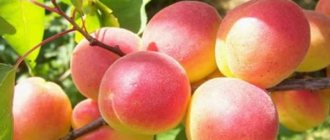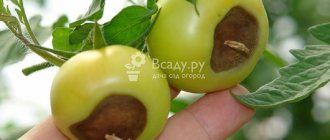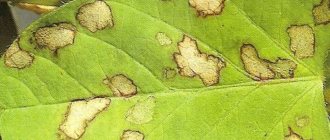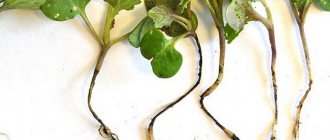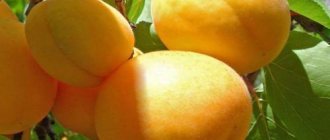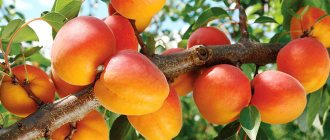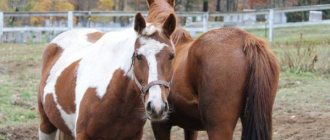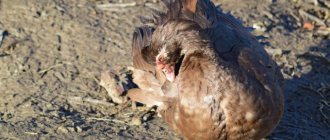Moniliosis of apricots
This fungal disease is most common in apricot trees. The causative agent of the disease is the monilia marsupial fungus.
For preventive purposes, apricot trees should be treated against this disease several times per season.
Photo of apricot moniliosis

Useful article:
Apple moniliosis
There are several forms of manifestation of this disease:
- The first form is a monilial burn. It manifests itself most often in the spring, when the buds of apricot trees begin to bloom. The main symptoms of the disease during this period is the twisting of the flowers, later they die off and fall off. The fungus begins to actively multiply, as a result, the foliage begins to mummify, cracks appear on the shoots, and the tree, in order to "seal" them, secretes a special liquid - gum. Outwardly, the apricot seems to be quite healthy, only slightly burnt. Favorable conditions for the development of this fungal disease are warm and humid winters and sudden temperature fluctuations during bud opening.
- The next form of moniliosis is fruit rot. It can affect apricot trees in the summer, while small dark specks first appear on ripening fruits, which gradually begin to rot. Apricot berries affected by fruit rot cannot be saved, so it is necessary to fight moniliosis at the first stage of the formation of this fungal disease.
The fight against moniliosis on the example of apricot treatment - video
In the spring, the following measures should be taken to prevent apricot moniliosis:
- diseased areas of the tree must be cut out to healthy wood;
- all parts of the tree affected by the fungus must be cut off and burned outside the site;
- after 12-14 days, the tree is examined again, if new affected areas are found, they are cut out;
- in the spring, when the buds on apricot trees begin to swell, this culture should be treated with Bordeaux liquid (3%), copper sulfate or any other copper-containing preparation;
- after the apricots have faded, they are treated for prophylactic purposes with "Horus", then every 8-10 days they are sprayed with a fungicide solution (Nitrafen, Confidor can be used), treatments with any preparations are stopped 12-14 days before harvesting.
Photo of the defeat of apricot branches by moniliosis
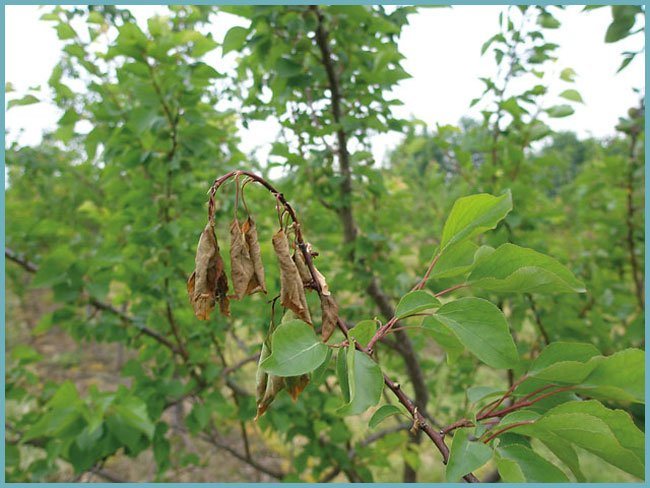

If the apricots are sick with fruit rot, then it is necessary to collect all the affected berries and destroy them outside the site. In the next season, most of the flowers are cut off from such trees in the spring, the apricots themselves must be thinned out and some of the shoots removed.
Useful article:
Moniliosis in cherry trees
Effective prevention against this fungal disease are:
- control of soil moisture;
- observe the required distance between adjacent trees;
- timely make shaping and sanitary pruning of apricots;
- to clear the tree trunks and the area as a whole from weeds;
- treat plants from pests that can carry fungi.
What is dangerous
Moniliosis, which manifests itself during flowering and fruiting, is dangerous because its development is unpredictable and rapid. A gardener can literally lose the entire crop in a few days, without having time to treat the apricot. In addition, the spores of the fungus are actively spreading, so even if there is one infected tree in the garden, then without taking preventive measures, the rest will also be infected.
Moniliosis is especially dangerous when the underground part of the tree is affected. When the fungus spreads to the root system, it will begin to dry out quickly, after which it will die.
Apricot gum therapy: what to do and how to treat
On the trunk of an apricot, you can sometimes find a sticky thick mass in the form of resin (or glue), diluted with tree sap. This mass is called gum. This substance is released by the tree in order to seal the cracks in the bark of the tree.
If too much of such a mass appears on apricots, then this disease is called hommosis.
Photo of gum leakage on the trunk of an apricot


Wounds on the trunks and shoots of apricots can appear for various reasons, and if the tree does not "cover up" them with gum, then pathogenic microorganisms and pests can penetrate into such cracks and abrasions, which ultimately destroy the wood.
But the formation of gum takes too much strength from this stone fruit tree, weakens it.
APPLE TREATMENT:
Apple tree care in autumn and preparation for winter
To prevent gum leakage, it is necessary to properly care for apricot trees:
- when caring for a tree, do not injure the bark of the trunk and shoots;
- it is impossible to prune shoots when the juice begins to move along the aerial part;
- grow on the site only those varieties of apricots that are zoned for a particular region.
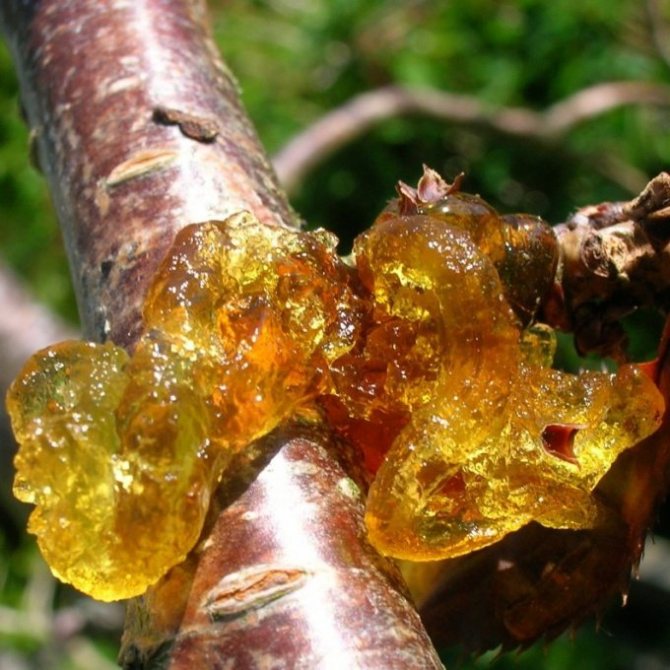

For preventive purposes, it is recommended to whitewash the trunk and skeletal branches several times a year:
after falling leaves in autumn, in winter, in early spring. Also, to prevent the release of this mass, it is necessary to ensure that there is a sufficient amount of calcium in the soil.
There can be many reasons for the appearance of gum in apricot trees, therefore, control measures will be different. Before you start to deal with gum flow, you need to determine its cause, because a healthy tree will not just release gum.
Gum therapy. How to deal with it - video
Leaves turn yellow and crumble in early summer
The defeat of apricots with fungal diseases often leads to the fact that their crown turns yellow and sheds foliage. Knowing the symptoms and causes of infections typical of apricot, you can not only recognize them in a timely manner and cure, but also prevent the development of most of them.
Chlorosis of apricot
The lack of chlorophyll in the leaves, which is formed when apricots are sick with chlorosis, significantly affects the process of photosynthesis.


The disease is non-infectious in nature, its cause is a whole complex of reasons:
- deficiency of trace elements, primarily iron, which is necessary for the formation of chlorophyll;
- damage to the root system as a result of freezing;
- lack of drainage with constant waterlogging of the soil, which leads to oxygen starvation;
- alkalization of the soil when applying too much lime or nitrogen.
Chlorosis is manifested by the blanching of the foliage, its falling off, the death of new bark on the branches and trunk.
To cope with small manifestations of chlorosis in apricots, spraying with a solution of ferrous sulfate will help. If the disease is caused by soil depletion or alkalization, the introduction of appropriate fertilizers - ammonium nitrate or rotted manure will help to correct the situation.
We recommend that you read the article on the correct feeding of apricots, depending on the season and age.
Gnomoniosis or brown spot


Signs of infection appear on the leaves in early June in subtle spots, gradually covering the entire leaf plate and causing it to twist and wilt. In the middle of summer, on the back side of the affected leaves, you can see an accumulation of black dots - fungal spores.
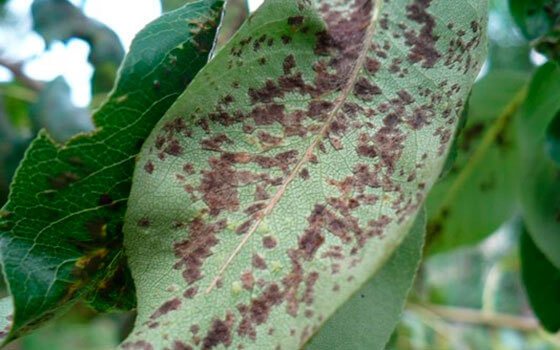

On fruits, brown spot appears as dry brown, gradually increasing spots. Their appearance leads to the fall of unripe fruits and a change in shape in more ripe ones. Trees weakened from the disease lay fewer fruit buds and shoots, freeze in winter.
A good way of prevention is the cultivation of varieties resistant to gnomoniosis.
Coccomycosis
Infection of apricot with coccomycosis is evidenced by the appearance of a red-brown spot on the leaves in May-June, which gradually increases. On the reverse side of the leaf, pinkish or grayish pustules with spores are formed. In case of severe damage, the petioles, young shoots and fruits with stalks are also covered with spotting.
Sick leaves early curl and fall off. Infected fruits remain underdeveloped, their pulp acquires a watery taste, the commercial qualities of such fruits are very low.
For methods of treatment and prevention of coccomycosis, see the video below:
Verticillosis
The disease is fungal in nature, its pathogens live in the soil. Affecting the apricot root system, verticillosis causes sudden foliage drying, which starts from the lower branches and gradually rises, reaching the upper part of the crown. At the same time, the inflorescences wither, and the fruits rot.
If signs of verticillosis are found, it is recommended to treat the tree with Topsin-M or Fundazol, otherwise the apricot will die.
How to get rid of scab on apricots
This disease can be caused by fungi or bacteria, they usually hibernate in the fallen leaves remaining on the site.
In spring, scab spores can be carried over long distances by wind or rain, affecting completely healthy apricots that may be in the neighboring area.
Photo of scab on apricot fruits


When the fungus begins to actively multiply, the water balance of apricot trees is disturbed, fruiting decreases, the foliage turns yellow and falls off prematurely, ripening fruits can deform and lose their attractive appearance.
Clasterosporium disease: signs and prevention
The spores of this fungus also affect apricots throughout the season, from bud formation to fruiting:


Clasterosporium disease
- Infected kidneys are darker than healthy ones, often filled with gum. They will not bloom along with the rest, but will remain tightly attached to the branch. Shoots under the buds are covered with dents and cracks. This can become a hotbed of infection.
- The leaves are covered with a reddish-purple edging, turning crimson in the middle. Over time, the damaged tissue dies off. The foliage looks perforated.
- Small reddish holes form on the fruit. Over time, their edges dry out.
To prevent the disease, the tree is treated with Bordeaux liquid:
- in the fall - after the leaves have fallen;
- in the spring - during the period of swelling of the kidneys.
Cytosporosis of apricot - what kind of animal and how to defeat it
Cytosporosis is one of the serious diseases that can lead to the death of an entire plant. The pathogenic microorganisms that cause the disease usually enter the space between bark and wood and live there.
Photo of cytosporosis of apricot
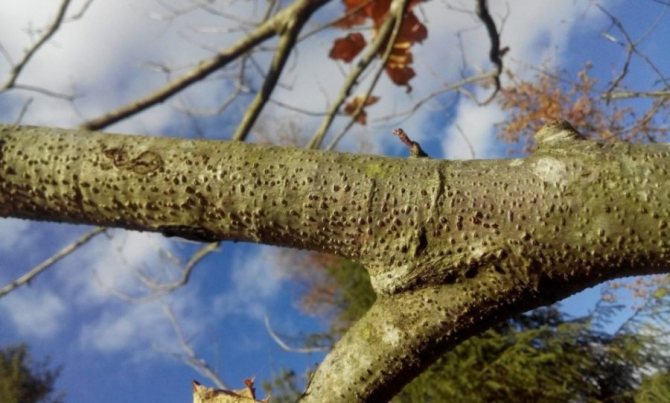

As a result of the influence of fungi on the aboveground part of the plants, the foliage on the upper shoots withers in the apricot, brown spots with a brown tint appear on the bark, and dark smudges appear.The whole tree is gradually affected - the foliage turns yellow, dries up and falls off ahead of schedule, the shoots also dry up, as a result this fruit tree dies.
To prevent this, you need to take care of the tree in the initial stage of the disease:
cut out affected shoots, infected bark and burn outside the garden area. Apricot can be cured only at the onset of the disease, until the cystoporosis fungus begins to damage the cambium.
All diseased bark is cut out, and the sections are treated with copper sulfate and covered with garden varnish. For preventive purposes, it is required to treat apricot trees with Bordeaux liquid in the spring-summer period.
Wild apricots have good cystoporosis resistance.
Causes of fungal infection
The Monilia fungus actively develops and is most active in humid and cool environments. That is why the peak incidence of moniliosis in apricots occurs in spring and autumn, when the weather often changes and frosts are frequent.
The spores of the fungus during the period of winter cold and intense summer heat are found near the affected tree in cracks in the bark, as well as on leaves and branches. However, as soon as the weather conditions are favorable, the fungus begins to multiply. During this time, spores are carried through the air, as well as through insects and birds.
In addition, the reasons for the development of the disease can be agrotechnical mistakes of the gardener, consisting in planting apricot trees in places with high humidity or close to the groundwater surface, as well as in excessive watering.
Preventive measures to protect the apricot from disease
To protect this capricious stone fruit tree from attack by pests and possible diseases, it should be provided with a set of measures - agrotechnical, to protect the tree (biological products and chemicals):
- carry out regular sanitary pruning in the spring and autumn;
- prevent thickening of the crown;
- in the spring, carry out preventive treatment of apricots in the spring before the start of sap flow with fungicidal preparations;
- maintain the cleanliness of the trunks - regularly remove weeds, loosen and mulch them;
- control soil moisture and timely dosed fertilizing;
- observe the rules of crop rotation and do not plant the apricot next to tobacco, strawberries, potatoes, and other vegetable plants from the Solanaceae family;
- be sure to cover the apricot for the winter, protect it from sudden fluctuations in air temperature;
- constantly monitor the condition of trees in order to detect signs of diseases or the presence of pests in time;
- remove all damaged parts in a timely manner and incinerate them immediately;
- in the event of a disease, it is necessary to strictly adhere to the instructions for combating it.
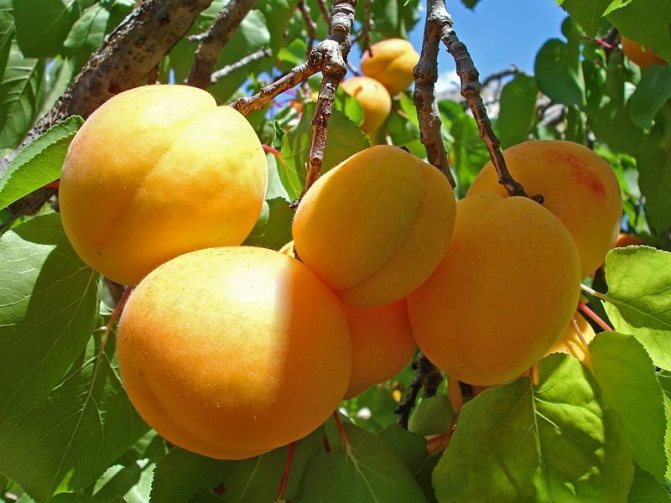

If all preventive measures are followed, apricots can be protected from possible diseases and the presence of pests.
With a timely detected disease and immediately started treatment, it is possible not only to save the crop, but also the tree itself.
Smallpox and other bacterial and viral ailments
- Smallpox plum is more inherent in different types of plums, but it can also move to the neighboring apricot. It covers the fruits with depressed brownish stripes and spots, accelerating their ripening. But at the same time, the taste deteriorates.
- Smallpox annular changes the shape of the leaves, slows down the growth of shoots and contributes to the death of branches. On the fruits, ring spots are also formed - a reddish-brown color.
- Viral wilt of apricot. Its hallmark is the simultaneous appearance of flowers and thick, curled leaves with white spots. The fruits are not filled with tasty juice, and the pulp is brownish. The disease can eventually destroy the entire tree.
- Tape mosaic is characterized by the appearance of yellow stripes on the leaves. The fabric of the plate deteriorates, falls off, turning into "lace".
Diseases of this type move from infected plants to healthy ones, while the radius can be very large: the wind and insects "work" on bacteria and viruses. Better medicine is prevention. Therefore, choose healthy seedlings, protect them from pests, fertilize correctly and loosen the soil - this will improve the health of the apricot and the entire garden.
Fertilizers to increase yields
Root top dressing of apricots allows you to increase yields in the next year. Fertilizers are applied in the middle of autumn. For deep digging, humus is used in an amount of up to 4 kg, potash fertilizers in the calculation of no more than 70 g per tree. Apricot responds well to the introduction of superphosphate. It is used in the calculation of 40 g / m2. Apricot responds well to mineral fertilizers. You can use wood ash to feed it.
